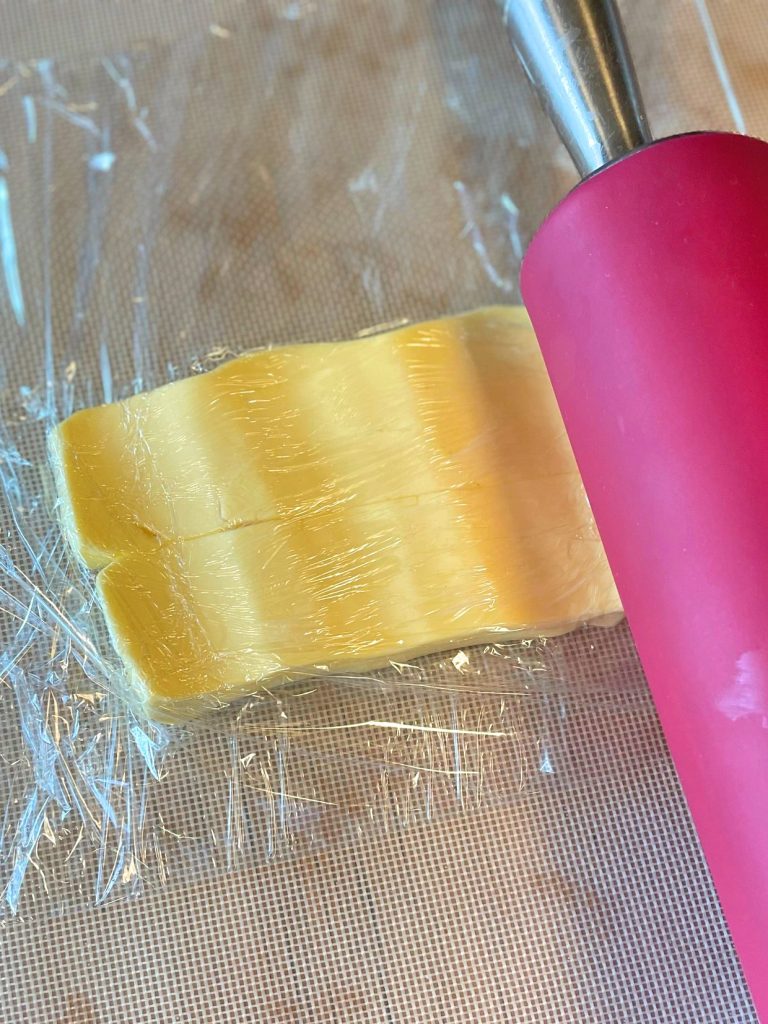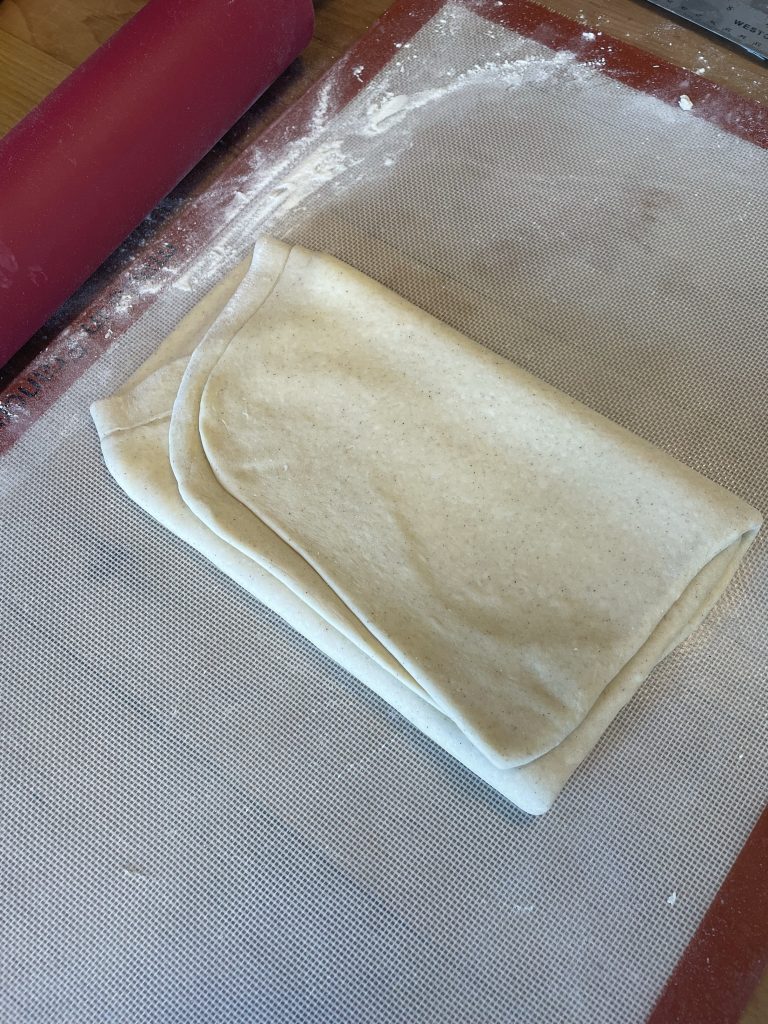The frøsnapper is a twist of Danish pastry filed with marzipan cream that’s dipped in poppy and sesame seeds before baking. Danes eat this buttery, crunchy, nutty and almondy pastry as a snack with coffee. In my next life, may I come back as a kid who eats frøsnapper after-school each day.
Although making Danish pastry is a small project, frøsnapper are easy to make. Give yourself a couple of days to produce these. Make the pastry on the first day then fill and bake the pastries on the second day.
Kitchen Notebook
Among the casualties of the pandemic is the Great Northern Food Hall in Manhattan’s Grand Central Station. Created in 2016 and run by Claus Meyer, the food hall filled Vanderbilt Hall where coffee, snacks, sandwiches and authentic Danish pastries were served. Meyer, a co founder of Noma in Copenhagen and proponent of the Nordic Food movement, could be seen training the staff and manning the counter where you’d find open-faced sandwiches like these.
Meyer uprooted his family for this ambitious project that included a commercial bakery and Agern, an upscale restaurant in Grand Central that earned one star Michelin. He was kind enough to speak with me about his ambitions for bringing Danish baking to the US. Look on the second shelf in the display case in the photo below. That’s a pile of frøsnapper waiting to be enjoyed with a cup of strong black coffee.
Danish pastry dough consists of layers of yeast dough and butter. It is a laminated dough like that used to make croissants. The butter is incorporated in stages during which the dough is rolled out and folded.
First you make a simple yeast dough that rises for a few hours. Here is the dough after rising.
While the dough rises you must form what is called a “block” of butter. This block is more like a thick sheet of butter. To make it, place the butter called for in the recipe, in this case two 4-ounce sticks, onto a long piece of plastic wrap. Cover the butter with plastic wrap then use a heavy rolling pin to pound it out into a flat rectangle.
Here I use my kitchen ruler to measure the butter block.
Then roll out the dough out into a large rectangle about 1/3-inch thick.
Unwrap then position the butter centered on one side of the dough.
Fold the dough over into an envelope and gently press the edges of dough together to seal the butter between the two layers of dough.
Start rolling out the dough into a large rectangle.
Fold the dough in thirds, first fold the left side over to cover two-thirds of the dough.
Then do the same with the right side.
Wrap in plastic and refrigerate the dough for 20 – 30 minutes.
Repeat the rolling, folding and refrigerating a total of 4 or 5 times. After the final turn, wrap the dough and refrigerate it for 6 hours or overnight.
Roll the dough out on a lightly floured surface into a rectangle approximately ¼-inch thick. It should measure approximately 14 x 20 inches. Use a palette knife or firm spatula to spread the filling into an even layer.
Fold the dough in half horizontally so that the two coated sides touch. Then brush it with egg wash.
Carefully dip the egg-wash-coated-side of dough into the seeds.
Turn the dough over, brush with egg wash then coat the other side of the dough with seeds.
Cut the dough into 1/3 to 1/2-inch-wide strips.
Twist each strip three times then place them on parchment paper lined baking sheets.
Let the formed dough proof until visibly risen and nearly doubled in sides. This may take from 1 to 1 1/2 hours depending on the temperature in your kitchen.
Here’s a fresh batch of the pastries cooling before eating.

Ingredients
½ cup (120 milliliters) milk
2 Tablespoons unsalted butter
1 ½ teaspoons instant yeast
2 ¾ cups (325 grams) all-purpose flour
¼ cup (50 grams) granulated sugar
½ teaspoon salt
½ teaspoon vanilla extract
½ teaspoon ground cinnamon
Two 4-ounce sticks (225 grams) cold unsalted butter
6 ounces (170 grams) quality almond paste, grated
2 tablespoons granulated sugar
2 tablespoons unsalted butter
1 large egg
1 tablespoon all-purpose flour
1 beaten egg
Poppy seeds
Sesame seeds
Directions
- To make the Danish Pastry, warm the milk and butter over medium heat until the butter melts. Set aside to cool to 90˚F.
- Pour the milk mixture into the bowl of a mixer fitted with the dough hook. Stir in the yeast to moisten it. Add the flour, sugar, salt vanilla and cinnamon. Stir the ingredients with a rubber spatula until the flour is moistened. Then knead the dough on medium speed until it comes together into a smooth ball, for approximately 4 – 5 minutes.
- Form the dough into a ball, place it in a bowl and cover. Let the dough ferment at room temperature for one hour then refrigerate it for another hour.
- While the dough ferments, form the cold butter into a block. Place the two sticks of butter touching on a large sheet of plastic wrap or parchment paper. Cover with another piece of plastic wrap or parchment paper. Pound and roll out the butter into an even rectangle that measures approximately 10 inches x 12 inches. Wrap the butter and refrigerate it for 15 minutes.
- On a lightly floured surface, roll out the dough into a large rectangle approximately 1/3-inch thick. Unwrap then position the butter centered on one side of the dough. Fold the dough over into an envelope and gently press the edges of dough together to seal the butter between the two layers of dough.
- Roll the dough out into a rectangle approximately 12 x 20 inches. Fold the dough in thirds, first fold the right side over to cover two-thirds of the dough. Then do the same with the left side. Wrap in plastic wrap and refrigerate the dough for 20 – 30 minutes.
- Repeat the rolling, folding and refrigerating a total of 4 or 5 times. After the final turn, wrap the dough and refrigerate it for 6 hours or overnight.
- To make the Marzipan Cream Filling, cream the grated almond paste and sugar in the bowl of a food processor fitted with the metal blade. Add the butter and pulse for 10–15 seconds. Scrape the sides of the bowl. Add the egg and blend for 15–20 seconds until smooth. Pulse in the flour. Refrigerate until needed. This filling will keep chilled for 5 days.
- To make and bake the pastries, line two half baking sheets with parchment paper. Bring the Marzipan Cream Filling to room temperature.
- Pour enough poppy seeds into a large dinner plate or platter to cover the bottom evenly. Do the same with the sesame seeds.
- Roll the dough out on a lightly floured surface into a rectangle approximately ¼-inch thick. It should measure approximately 14 x 20 inches. Use a palette knife or firm spatula to spread the filling into an even layer. Fold the dough in half horizontally so that the two coated sides touch.
- To make the dough easier to work with cut it into two pieces that measure approximately 7 x 10 inches.
- Working with one piece at a time, brush one side of the filled dough with egg wash then carefully dip it in the poppy seeds. Turn the dough over and place it on your worktable. Brush the other side of the dough with egg wash then dip it in the sesame seeds. Place the seed-coated-dough on a cutting board with the folded edge parallel to the countertop. Using a long knife working from the fold to the edge, carefully cut the dough into ½ -inch-wide strips.
- Shape each piece of dough by twisting the ends in opposite directions three or four times. Place the twists of dough spaced about 1 inch apart on the prepared baking sheets. Cover loosely with plastic and let the dough proof until nearly doubled, from 1 to 1 ½ hours depending on the temperature in your kitchen. Preheat the oven to 375°F while the dough proofs. Place a small cast iron or other ovenproof container on the bottom of the oven. (This will be used for water to make steam.)
- Carefully pour ½ cup hot water into the pan in the bottom of the oven. Uncover and place the proofed dough in the oven. Bake until the pastries are golden brown and cooked through, for 25 – 30 minutes. Cool the pastries on a wire rack. Serve the pastries within a day of preparing. For longer storage, place the pastries well sealed in covered containers. Freeze them for up to one month. Thaw then reheat before serving.



























